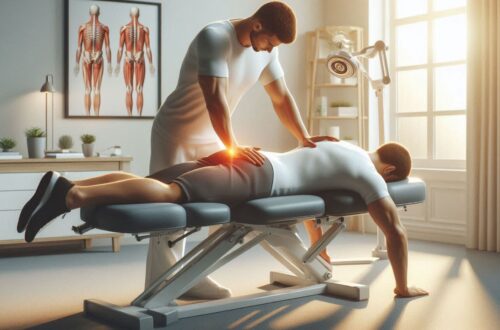Lower back pain is one of the most common health complaints worldwide. Whether you spend long hours at a desk, work in a physically demanding job, or maintain an active lifestyle, chances are you’ve experienced it at some point. In fact, the World Health Organization (WHO) estimates that lower back pain is the leading cause of disability globally.
The good news? You don’t have to accept back pain as a normal part of life. Wellness coaches are increasingly helping clients use ergonomics—the science of designing environments to fit the body—to reduce pain, prevent injuries, and improve overall well-being.
In this guide, we’ll explore how ergonomics, posture, simple exercises, and lifestyle changes can transform the way you move, work, and feel every day.
Why Ergonomics Matter for Your Back
Ergonomics isn’t just for office workers. It’s about creating an environment—whether at home, at work, or on the go—that supports your body instead of working against it.
When your chair, desk, or screen is poorly positioned, your muscles compensate by hunching, twisting, or overstretching. Over time, this leads to:
- Muscle fatigue and stiffness
- Poor circulation
- Increased pressure on spinal discs
- Chronic lower back pain
Wellness coaches emphasize that small ergonomic adjustments often prevent big health problems down the line.

Easy Tips to Improve Your Posture
Poor posture is a silent contributor to back pain. Here are expert-backed tips wellness coaches share:
- Sit tall – Keep shoulders relaxed, feet flat, and hips slightly higher than your knees.
- Use lumbar support – A rolled towel or pillow behind your lower back encourages a neutral spine.
- Stand balanced – Avoid shifting weight onto one hip.
- Break the slump cycle – Set a timer to move every 30–45 minutes.
- Check in – Every so often, do a quick mental scan of your posture.
These adjustments may feel awkward at first, but with practice, good posture becomes effortless.

Also Read: What Techniques do Doctors Recommend for Acute Pain Relief?
Setting Up an Ergonomic Workspace
If you spend hours working at a desk, an ergonomic setup is essential. Here’s a checklist wellness coaches often use:
| Component | Ideal Setup | Why It Matters |
|---|---|---|
| Desk height | Elbows bent at ~90° | Prevents shoulder and wrist strain |
| Chair | Adjustable, lumbar support, knees at hip level | Maintains spinal alignment |
| Monitor | Eye level, arm’s length away | Reduces neck strain |
| Keyboard & Mouse | Close to body, wrists straight | Minimizes repetitive stress |
| Footrest | If feet don’t touch floor | Improves circulation |
Even one or two changes can significantly reduce daily pain.

Also Read: What are the Latest Expert‑Approved Methods for Injury Recovery?

Stretching and Exercises to Keep Back Pain Away
Movement is medicine. Adding simple stretches and strength moves to your day can loosen tight muscles and protect your back.
Daily Stretches:
- Cat-Cow Stretch
- Knee-to-Chest
- Seated Spinal Twist
Core + Stability Moves:
- Bird Dog
- Planks (start with 20–30 seconds)
- Glute Bridges
Wellness coaches often suggest “movement snacks”—short bursts of stretching or exercise every hour instead of one long workout at the end of the day.
Strengthening Your Core for Long-Term Support
Think of your core as the corset for your spine. The stronger it is, the less strain your lower back has to bear.
Recommended exercises include:
- Superman lift – Targets lower back muscles.
- Side Planks – Strengthens obliques for stability.
- Deadlifts (light weights or bodyweight) – Trains hips and glutes.
- Reverse Hyperextensions – Engages spinal erectors safely.
By training your core 2–3 times per week, you build resilience against back injuries.

Lifestyle Habits That Protect Your Back
Wellness is more than just posture and workouts. Coaches encourage clients to look at their whole lifestyle, including:
- Healthy weight management – Reduces unnecessary load on the spine.
- Daily activity – Walking, yoga, or swimming all improve mobility.
- Stress reduction – Chronic tension often manifests as back tightness.
- Sleep hygiene – A supportive mattress and consistent sleep schedule aid recovery.
- Supportive footwear – Cushioned shoes reduce impact on joints.

Also Read: How do Experts Suggest Managing Chronic Pain Naturally?
Lifestyle Habits That Protect Your Back
Wellness is more than just posture and workouts. Coaches encourage clients to look at their whole lifestyle, including:
- Healthy weight management – Reduces unnecessary load on the spine.
- Daily activity – Walking, yoga, or swimming all improve mobility.
- Stress reduction – Chronic tension often manifests as back tightness.
- Sleep hygiene – A supportive mattress and consistent sleep schedule aid recovery.
- Supportive footwear – Cushioned shoes reduce impact on joints.
Conclusion
Lower back pain doesn’t have to control your life. With the help of wellness coaches and ergonomic strategies, you can redesign your environment and daily habits to support your body instead of straining it.
From posture corrections to personalized exercise routines, small changes add up to big relief. By embracing ergonomics, you’re not just preventing pain—you’re investing in long-term health and productivity.
👉 Next Step: Try one ergonomic adjustment today—whether it’s raising your monitor, adding lumbar support, or standing up for a quick stretch. Your back will thank you.
Frequently Asked Question (FAQs)
Q1. Can ergonomics completely prevent back pain?
Not always, but it can significantly reduce risk and severity. Other factors—like stress, weight, and sleep—also play a role.
Q2. Do I need expensive ergonomic furniture?
Not necessarily. Even affordable adjustments like cushions, monitor risers, or footrests can make a big difference.
Q3. How long until I notice results?
Most people feel improvements within 2–6 weeks of consistent ergonomic changes and exercise.
Q4. Is standing at a desk better than sitting?
Both have pros and cons. Wellness coaches recommend alternating between sitting and standing throughout the day.
Q5. Can kids and teens benefit from ergonomics?
Yes. With increased screen time, teaching young people proper posture and workspace setup is essential.






